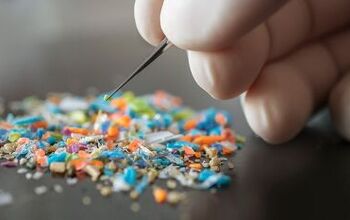Do I Need Gravel in My Fish Tank or Aquarium?

Are you newer to fish keeping or considering setting up your first aquarium? If so, you likely already have many questions - there is much to consider! However, unlike adopting a dog or a cat, most pet stores will sell fish without offering too much information about how to set up the best tank or aquarium for their long-term health and well-being. If you’re feeling overwhelmed or confused, you’re not alone.
When I decided to set up my first fish aquarium, I had very little information to go on. Until that point in my life, the only fish I cared for were goldfish in a less-than-ideal goldfish bowl setup. Of course, at that time, I didn’t know better. However, having researched and learned more about their needs and the ideal environment, I was committed to creating the best environment for my new fish friends. The problem was, I wasn’t sure what that meant…
One product that I saw everywhere I looked was aquarium gravel, but I quickly realized that not all gravel is created equal. Even more perplexing, not all aquariums had gravel or SHOULD have gravel.
To help you navigate the many options available and get started with your aquarium on the right foot, I wanted to share some vital information about the use of gravel in fish tanks and aquariums, including the answer to whether you need gravel in your fish tank, the best gravel substrate to use, and some basic care tips for maintaining the gravel in your tank moving forward.
What is Aquarium Gravel?
Aquarium gravel refers to the small rocks or pebbles at the bottom of a fish tank or aquarium. They can vary significantly in size and color. Colourful gravel, as you often see in beginner fish tank sets or children’s fish tanks, can add a fun element to the visual appearance of the tank. However, many experts warn that the bright colors, while appealing to children, may be distracting or upsetting for the fish. For this reason, these experts often recommend a more neutral color or natural-looking gravel option.
How much truth is in that statement is still unknown. What we do know is that many of the more ornamental and popular fish, like goldfish, don’t appear to be bothered by the vibrant stones. But we do know that the quality of your gravel, regardless of its appearance, is important. Cheaply made and mass-produced aquarium gravels often flake off bits of paint over time, adding toxins and particles to the water that could make your fish sick.
When choosing aquarium gravel, try to avoid the cheapest products available. Instead, look for a well-known and trusted brand. Rinse off the gravel before using it, removing any flakes that may have come off during transport. Finally, as you’re cleaning your fish tank or aquarium, pay attention to signs of wear that may indicate it’s time to replace your substrate.
6 Benefits of Including Gravel in Your Aquarium
There is no one-size-fits-all option for aquarium substrate. From gravel to crushed coral, sand to glass stones, they each have benefits that they may offer in the right environment.
Here are some key benefits of using gravel in your aquarium:
- Gravel does better at hiding debris than finer substrate options, like sand. Debris can easily fall into the gaps between the little stones until it is cleaned.
- It is easier to clean using a simple gravel vacuum.
- It encourages healthy bacteria and beneficial microorganisms to grow and survive by providing them with a safe environment with the waste products they need readily accessible.
- For those planning on having live plants, gravel provides a surface that allows for the growth of strong, healthy roots.
- Using gravel means you have more options to choose from when it comes to filtration, like under gravel filters.
- There are more options for aesthetic choices if you are trying to create a specific look or incorporate a theme into your aquarium.
Of course, this isn’t to say that the use of gravel is without its struggles. For example, the benefit of a gravel surface hiding debris also means that food is often wasted as it falls into those little gaps out of reach for your fish. But for many fish keepers, the pros far outweigh the cons.
What Color Gravel is Best for a Fish Tank?
There are many different schools of thought when selecting the best gravel colors for your tank. First, consider the happiness and safety of your fish. As we already discussed, many popular types of fish (like goldfish) appear to be completely unphased by brightly-colored gravel, fueling the ongoing debate of whether it is actually problematic. However, some fish species need a more natural environment for camouflage.
If you are raising fish that fall into the category of being unphased by gravel colors, you can consider how that can impact the overall visual of your aquarium. This includes the overall color scheme of the tank and how it may complement the decorations you plan to include. You can also choose colors that will help your fish stand out. For example, if you have a bright blue fish, blue gravel will camouflage its colors, but black gravel will provide a solid background for it to stand out.
Finally, there are a few other factors to consider, like ease of cleaning. Light-colored gravel will show dirt and debris more than darker gravel.
How Do I Keep My Fish Tank Gravel Clean?
While gravel effectively hides debris in your tank, that doesn’t mean the waste is “gone.” Instead, it builds up in and among the stones. Even if you are cleaning the water regularly, dirty aquarium gravel can quickly contaminate the new water, undoing all the hard work that you’ve done and negatively impacting the water's balance.
The easiest and most effective way to clean your fish tank gravel is by using a gravel vacuum. This is a straightforward device both in construction and use, but it does a great job of removing any loose debris in and among the stones.
Moving the rigid tube in and around the gravel will stir up the debris in the gravel, siphoning it out of the tank and into a bucket. But it will also be removing water from the tank as you are cleaning, so pay careful attention to how long you are cleaning and the water level in your tank to avoid removing too much.
If you are new to using a gravel vacuum and, therefore, a little slower with the process, you may want to start by cleaning only a portion of the tank’s surface at a time.
Can You Have a Fish Tank Without Gravel?
Whether you dislike the look of gravel in an aquarium or have a more functional reason to want to skip the little stones, you’re in luck! Gravel is the most commonly used substrate, but it is not the only option available. There are also some situations where the use of aquarium gravel could be detrimental or harmful to the ecosystem you are setting up.
Let’s take a moment to explore why you may wish to consider not using aquarium gravel and the other options you should consider.
Situations When Gravel May Not Be the Best Substrate
In some situations, aquarium gravel is not the ideal choice for your tank. Recognizing this will allow you to set up the best tank for your fish’s needs. There are also some fish-keeping situations in which gravel simply isn’t the preferred option, such as the standard saltwater aquarium setup.
Here are a few reasons why you may want to explore an alternative substrate:
Hospital Tanks
Like any other pet, there are times when you may need to care for an ill or diseased fish. Consider, for a moment, the last time you set foot in a human hospital. The conditions are clean and sanitary to reduce the possibility of cross-contamination or reducing the effectiveness of treatment. The same is true in your hospital tank.
Setting up a tank with gravel effectively hides debris, but those little spaces between the stones also create the perfect place for harmful pathogens to linger and spread. The most sanitary environment for your fish to recover is a bare-bottom tank, meaning no substrate is used.
The same line of thought applies to the setup of a quarantine tank. These tanks are used when bringing new fish home to ensure they aren’t carrying any diseases or pathogens before introducing them to your main aquarium and the existing fish. If one of the fish is ill, you want to have a tank that is easy to clean and disinfect to prevent the potential spread of disease.
Breeding Tanks
If you are exploring the possibility of breeding and raising new fish, you may want to avoid the use of aquarium gravel. When the eggs hatch, the young fry (babies) are tiny and often confused for waste and debris around the tank. This means these tanks are more challenging to clean without risking the unintentional loss of young fry.
There is a risk anytime you change the water or clean that can’t completely be avoided while maintaining a clean tank – but you can reduce this risk significantly by eliminating the need for vacuuming a gravel substrate.
Sand-Sifting Fish
Some fish breeds are known to dig down into the sand at the bottom of their environment. This could be a form of camouflage, allowing them to hide from predators in the wild effectively. Other fish will dig to create a pit for laying their eggs. Others still will use rock crevices or burrowing in the sand to hide when hunting for food.
If you introduce these fish into an aquarium with gravel, you are taking away their opportunity to engage in this natural behavior. They may try digging into the gravel, rubbing against rough stones that could cause injuries. Alternatively, the inability to create a safe shelter could stress them out to the point of making them ill.
If Your Fish is Showing Signs of Stress
As we already discussed, fishkeeping experts are still unsure whether brightly colored aquarium gravel causes stress in fish. For this reason, it is our job as fishkeepers to watch for signs of stress and address it accordingly. Failing to reduce stress in your fish could open the door to disease, bacterial infections, fungi growth, and other illnesses.
Common signs of stress in fish include the following:
- Loss of appetite
- Scraping their body against the rocks or gravel
- Darting around the tank (known as “flitting”)
- Hiding more than usual
- Swimming into decorations or the sides/bottom of the tank
- Gasping for air at the surface
If you notice any of the above signs of stress, take a moment to reevaluate your current setup. Stress could be caused by fluctuations in pH levels and other water conditions, a lack of hiding places, the behavior of other fish in the tank, or inadequate tank size. But in an appropriately sized tank with adequate hiding places and balanced water conditions, you may want to change the substrate to see if it is the cause of concern.
What is the Best Alternative to Gravel in a Fish Tank?
There are several aquarium substrate options for you to consider depending on the type of fish you are raising, your overall tank setup, and the visual that you are trying to create. Live-planted aquariums may be better suited for one type of substrate. In contrast, a more decorative tank with artificial plants and aquarium décor may be supported best with another.
Here are some of the most common alternatives to aquarium gravel:
- Bare-bottom tanks
- Live rock
- River stone
- Crushed coral
- Sand
- Peat
- Limestone
- Clay-based substrates like Laterite and Flourite
- Aquasoil
- Tumbled glass chips or crystal
Final Thoughts: Do I Need Gravel in My Fish Tank?
When selecting the best substrate for your fish tank or aquarium, there are several factors to consider. This includes the purpose of the tank you are setting up, the type of fish you plan to raise, and the overall visual appearance you are trying to achieve. Aquarium gravel is the most common choice but isn’t the only available option. By exploring your options, you can set up an aesthetically pleasing tank that meets all the needs of the fish, coral, and live plants you are keeping.

Britt Kascjak is a proud pet mom, sharing her heart (and her home) with her “pack” which includes her husband John, their 2 dogs – Lucifer and Willow – and their 2 cats – Pippen and Jinx. She has been active in the animal rescue community for over 15 years, volunteering, fostering and advocating for organizations across Canada and the US. In her free time, she enjoys traveling around the country camping, hiking, and canoeing with her pets.
More by Britt
























